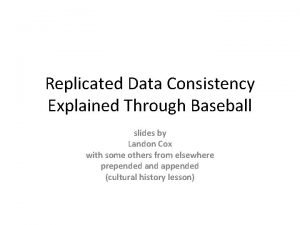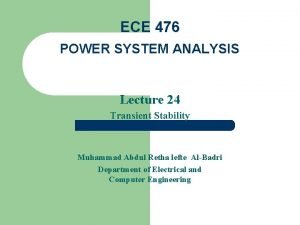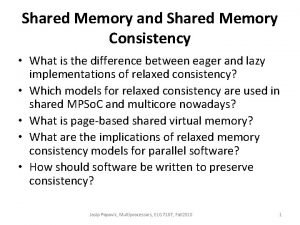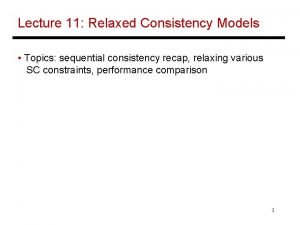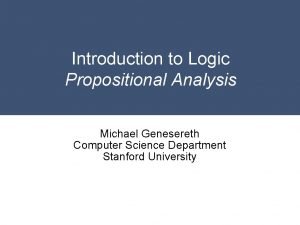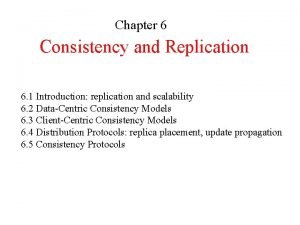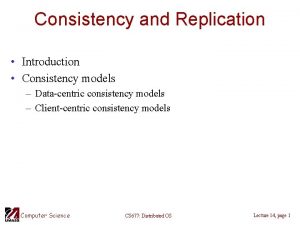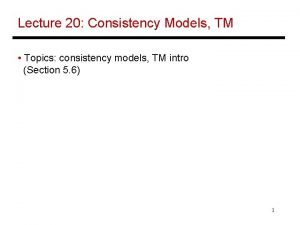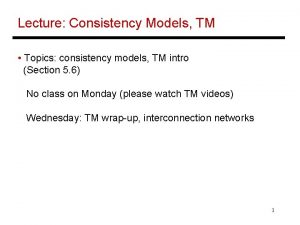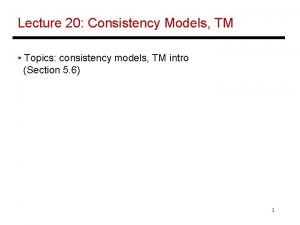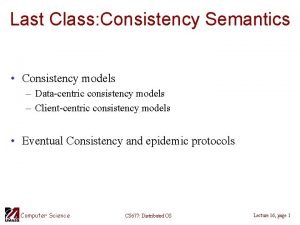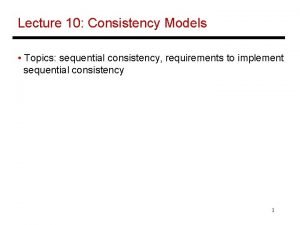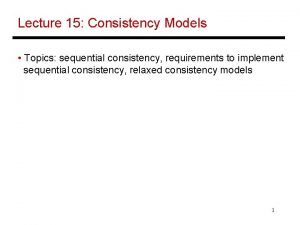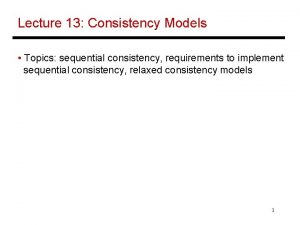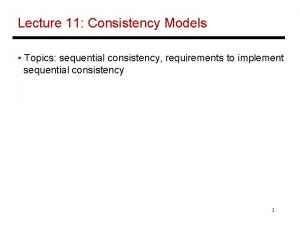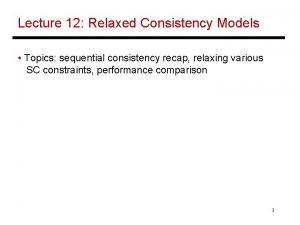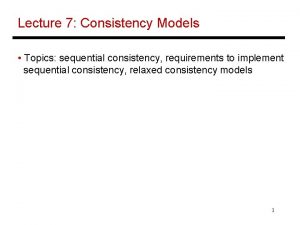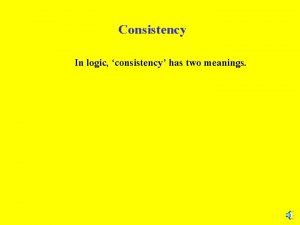Lecture 20 Consistency Models TM Topics consistency models















![Example Hash table implementation transaction begin index = hash(key); head = bucket[index]; traverse linked Example Hash table implementation transaction begin index = hash(key); head = bucket[index]; traverse linked](https://slidetodoc.com/presentation_image_h2/0be5d199cd7b7989c7c6feeb851b1d46/image-16.jpg)




- Slides: 20

Lecture 20: Consistency Models, TM • Topics: consistency models, TM intro (Section 5. 6) 1

Coherence Vs. Consistency • Recall that coherence guarantees (i) that a write will eventually be seen by other processors, and (ii) write serialization (all processors see writes to the same location in the same order) • The consistency model defines the ordering of writes and reads to different memory locations – the hardware guarantees a certain consistency model and the programmer attempts to write correct programs with those assumptions 2

Example Programs Initially, Head = Data = 0 Initially, A = B = 0 P 1 A=1 if (B == 0) critical section P 2 B=1 if (A == 0) critical section P 1 Data = 2000 Head = 1 P 2 while (Head == 0) {} … = Data Initially, A = B = 0 P 1 A=1 P 2 P 3 if (A == 1) B=1 if (B == 1) register = A 3

Sequential Consistency P 1 Instr-a Instr-b Instr-c Instr-d … P 2 Instr-A Instr-B Instr-C Instr-D … We assume: • Within a program, program order is preserved • Each instruction executes atomically • Instructions from different threads can be interleaved arbitrarily Valid executions: ab. Ac. BCDde. E… or ABCDEFab. Gc… or abc. Ad. Be… or a. Ab. Bc. Cd. De. E… or …. . 4

Sequential Consistency • Programmers assume SC; makes it much easier to reason about program behavior • Hardware innovations can disrupt the SC model • For example, if we assume write buffers, or out-of-order execution, or if we drop ACKS in the coherence protocol, the previous programs yield unexpected outputs 5

Consistency Example - I • An ooo core will see no dependence between instructions dealing with A and instructions dealing with B; those operations can therefore be re-ordered; this is fine for a single thread, but not for multiple threads Initially A = B = 0 P 1 P 2 A 1 B 1 … … if (B == 0) if (A == 0) Crit. Section The consistency model lets the programmer know what assumptions 6 they can make about the hardware’s reordering capabilities

Consistency Example - 2 Initially, A = B = 0 P 1 A=1 P 2 P 3 if (A == 1) B=1 if (B == 1) register = A If a coherence invalidation didn’t require ACKs, we can’t confirm that everyone has seen the value of A. 7

Sequential Consistency • A multiprocessor is sequentially consistent if the result of the execution is achieveable by maintaining program order within a processor and interleaving accesses by different processors in an arbitrary fashion • Can implement sequential consistency by requiring the following: program order, write serialization, everyone has seen an update before a value is read – very intuitive for the programmer, but extremely slow • This is very slow… alternatives: Ø Add optimizations to the hardware Ø Offer a relaxed memory consistency model and fences 8

Example Programs Initially, Head = Data = 0 Initially, A = B = 0 P 1 A=1 if (B == 0) critical section P 2 B=1 if (A == 0) critical section P 1 Data = 2000 Head = 1 P 2 while (Head == 0) {} … = Data Initially, A = B = 0 P 1 A=1 P 2 P 3 if (A == 1) B=1 if (B == 1) register = A 9

Relaxed Consistency Models • We want an intuitive programming model (such as sequential consistency) and we want high performance • We care about data races and re-ordering constraints for some parts of the program and not for others – hence, we will relax some of the constraints for sequential consistency for most of the program, but enforce them for specific portions of the code • Fence instructions are special instructions that require all previous memory accesses to complete before proceeding (sequential consistency) 10

Fences P 1 { P 2 { Region of code with no races } } Fence Acquire_lock Fence { { Racy code } Fence Release_lock Fence 11

Relaxing Constraints • Sequential consistency constraints can be relaxed in the following ways (allowing higher performance): Ø within a processor, a read can complete before an earlier write to a different memory location completes (this was made possible in the write buffer example and is of course, not a sequentially consistent model) Ø within a processor, a write can complete before an earlier write to a different memory location completes Ø within a processor, a read or write can complete before an earlier read to a different memory location completes Ø a processor can read the value written by another processor before all processors have seen the invalidate Ø a processor can read its own write before the write is visible to other processors 12

Transactions • New paradigm to simplify programming § instead of lock-unlock, use transaction begin-end § locks are blocking, transactions execute speculative in the hope that there will be no conflicts • Can yield better performance; Eliminates deadlocks • Programmer can freely encapsulate code sections within transactions and not worry about the impact on performance and correctness (for the most part) • Programmer specifies the code sections they’d like to see execute atomically – the hardware takes care of the rest (provides illusion of atomicity) 13

Transactions • Transactional semantics: § when a transaction executes, it is as if the rest of the system is suspended and the transaction is in isolation § the reads and writes of a transaction happen as if they are all a single atomic operation § if the above conditions are not met, the transaction fails to commit (abort) and tries again transaction begin read shared variables arithmetic write shared variables transaction end 14

Example Producer-consumer relationships – producers place tasks at the tail of a work-queue and consumers pull tasks out of the head Enqueue transaction begin if (tail == NULL) update head and tail else update tail transaction end Dequeue transaction begin if (head->next == NULL) update head and tail else update head transaction end With locks, neither thread can proceed in parallel since head/tail may be updated – with transactions, enqueue and dequeue can proceed in parallel – transactions will be aborted only if the queue is nearly empty 15
![Example Hash table implementation transaction begin index hashkey head bucketindex traverse linked Example Hash table implementation transaction begin index = hash(key); head = bucket[index]; traverse linked](https://slidetodoc.com/presentation_image_h2/0be5d199cd7b7989c7c6feeb851b1d46/image-16.jpg)
Example Hash table implementation transaction begin index = hash(key); head = bucket[index]; traverse linked list until key matches perform operations transaction end Most operations will likely not conflict transactions proceed in parallel Coarse-grain lock serialize all operations Fine-grained locks (one for each bucket) more complexity, more storage, concurrent reads not allowed, concurrent writes to different elements not allowed 16

TM Implementation Core Cache • Caches track read-sets and write-sets • Writes are made visible only at the end of the transaction • At transaction commit, make your writes visible; others may abort 17

Detecting Conflicts – Basic Implementation • Writes can be cached (can’t be written to memory) – if the block needs to be evicted, flag an overflow (abort transaction for now) – on an abort, invalidate the written cache lines • Keep track of read-set and write-set (bits in the cache) for each transaction • When another transaction commits, compare its write set with your own read set – a match causes an abort • At transaction end, express intent to commit, broadcast write-set (transactions can commit in parallel if their write-sets do not intersect) 18

Summary of TM Benefits • As easy to program as coarse-grain locks • Performance similar to fine-grain locks • Speculative parallelization • Avoids deadlock • Resilient to faults 19

Title • Bullet 20
 Bitcoin
Bitcoin 01:640:244 lecture notes - lecture 15: plat, idah, farad
01:640:244 lecture notes - lecture 15: plat, idah, farad Client-centric consistency models
Client-centric consistency models Shared memory consistency models: a tutorial
Shared memory consistency models: a tutorial Monotonic write consistency
Monotonic write consistency Memory consistency
Memory consistency Difference between modal and semi modal verbs
Difference between modal and semi modal verbs Product line decisions
Product line decisions Verb consistency
Verb consistency Consistent pronoun
Consistent pronoun Relaxed consistency
Relaxed consistency Processor consistency model
Processor consistency model Recoverability adalah
Recoverability adalah Mobile identity consistency
Mobile identity consistency Consistency limits in geotechnical engineering
Consistency limits in geotechnical engineering Building internally consistent compensation system
Building internally consistent compensation system Brain consistency
Brain consistency Dysphagia diet levels handout
Dysphagia diet levels handout Logical entailment examples
Logical entailment examples Explain data centric consistency model
Explain data centric consistency model Data centric consistency model
Data centric consistency model
